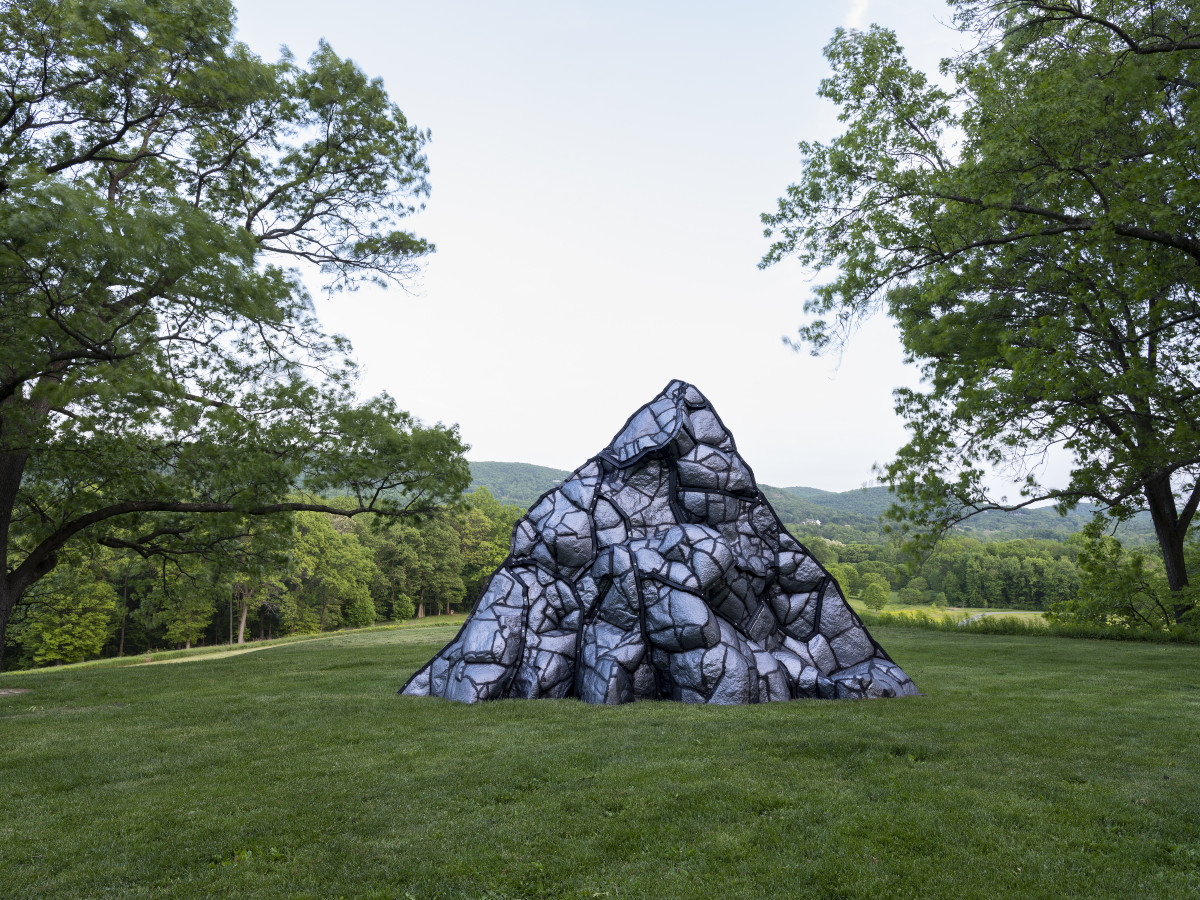Off view

Ilopango, the Volcano that Left, 2023
Steel
Courtesy the artist and Commonwealth and Council
Photo by Jeffrey Jenkins
Sited on Museum Hill with views of the Hudson Highlands in the distance, Ilopango, the Volcano that Left (2023) is a speculative reconstruction of an ancient volcano that erupted in the sixth century C.E. in what is now El Salvador. The 12-foot-tall volcano is rendered through the artist’s process of welding sheets of hammered steel. Cortez’s weld marks spread across the surface of the work like cracks or fissures, evoking a geologic formation.
The Ilopango eruption, the ash-spread of which would later come to be known as Tierra Blanca Joven (Young White Earth), was one of the largest volcanic events in recorded history. What remains today at the original site of the eruption is a volcanic caldera, Lake Ilopango. While there are no historical visual representations of the volcano, Ilopango looms large in history, its presence felt throughout the environmental and societal changes that it generated. Cortez’s sculpture imagines what Ilopango might have looked like. Today, ash deposits from Tierra Blanca Joven can be found in ice core samples as far away as Greenland, reflecting the extent to which the eruption spread across the planet.
Cortez likens the movement of volcanic particles to migration, echoing the movement of the Maya who were displaced after the cataclysmic eruption, and the artist’s own migration centuries later amid the violence of the Salvadoran Civil War in 1989. About the work, Cortez has said, “My objective is to invite others to imagine long temporalities of the planet, and the Earth in flow at speeds that are too long for us to perceive from our human perspectives and senses. In part, my travels are speculative, they are an effort to trace some of the trajectories followed by Tierra Blanca Joven centuries ago, and they are meant to imagine migration as part of the future and not only as part of our present.”
In the fall, Ilopango will leave Storm King to travel up the Hudson River by boat to its next destination: EMPAC—the Curtis R. Priem Experimental Media and Performing Arts Center at Rensselaer Polytechnic Institute in Troy, New York. A weekend of programming in collaboration with EMPAC and the Vera List Center for Art and Politics at The New School will allow visitors to witness the sculpture’s continued migration along the currents of the Hudson. As its title suggests, Ilopango, the Volcano that Left moves with a sense of agency, disrupting distinctions between here and there, past and present, as it charts its own future.
The Ilopango eruption, the ash-spread of which would later come to be known as Tierra Blanca Joven (Young White Earth), was one of the largest volcanic events in recorded history. What remains today at the original site of the eruption is a volcanic caldera, Lake Ilopango. While there are no historical visual representations of the volcano, Ilopango looms large in history, its presence felt throughout the environmental and societal changes that it generated. Cortez’s sculpture imagines what Ilopango might have looked like. Today, ash deposits from Tierra Blanca Joven can be found in ice core samples as far away as Greenland, reflecting the extent to which the eruption spread across the planet.
Cortez likens the movement of volcanic particles to migration, echoing the movement of the Maya who were displaced after the cataclysmic eruption, and the artist’s own migration centuries later amid the violence of the Salvadoran Civil War in 1989. About the work, Cortez has said, “My objective is to invite others to imagine long temporalities of the planet, and the Earth in flow at speeds that are too long for us to perceive from our human perspectives and senses. In part, my travels are speculative, they are an effort to trace some of the trajectories followed by Tierra Blanca Joven centuries ago, and they are meant to imagine migration as part of the future and not only as part of our present.”
In the fall, Ilopango will leave Storm King to travel up the Hudson River by boat to its next destination: EMPAC—the Curtis R. Priem Experimental Media and Performing Arts Center at Rensselaer Polytechnic Institute in Troy, New York. A weekend of programming in collaboration with EMPAC and the Vera List Center for Art and Politics at The New School will allow visitors to witness the sculpture’s continued migration along the currents of the Hudson. As its title suggests, Ilopango, the Volcano that Left moves with a sense of agency, disrupting distinctions between here and there, past and present, as it charts its own future.
